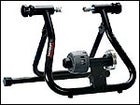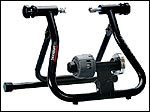First question to settle: Trainer or roller? A trainer is a device that clamps onto the bike and holds it securely, allowing you to pedal away rather mindlessly while reading, watching TV, whatever. A friction-creating device鈥攆ans, magnets, liquid-filled chambers鈥攑rovides resistance.
 TrakStand Mag 3
TrakStand Mag 3
Meanwhile, rollers don’t hold the bike鈥攜ou actually “ride” on the rollers, which forces you to pay a little more attention. Roller aficionados say that rollers more closely replicate the actual biking experience and help you with balance and the like.
Lots of models of each available, in a wide range of prices. Blackburn’s TrakStand Mag 3 Trainer ($160, www.blackburndesign.com) is a reliable model at a decent price. Like most trainers on the market these days, it clamps onto rear wheels only鈥攜ou buy a separate wheel holder (about $10) to keep the front wheel from wobbling around. The TrakStand has three resistance levels in its magnetized friction unit, and folds up easily.
For a step up, take a look at the CycleOps Fluid2 Trainer ($300, www.cycle-ops.com). Fluid-resistance devices are smoother and ride more “naturally” than magnets, so that’s why the price is higher. This one’s a very nice unit鈥攍ike the Blackburn, compact and easily stored. If you win the lottery, CycleOps 9400 Electronic Trainer has programmable “rides” and various fitness and interval routines. And it tracks heart rate, calories burned, and more. All for a very reasonable $700. For that much, you could fly to Palm Springs and bike in the sun…
On the rollers side, Kreitler rollers typically are seen as the gold standard. The basic unit is the Poly-Lyte Roller ($290, www.kreitler.com). This folds up nicely and easily adjusts to your wheelbase. Performance Bicycle offers its own take on rollers for an affordable $180 (www.performancebike.com).
So there you go. I’ve managed to stay off my trainer all winter鈥攂een riding, but manage to get out and do it. Trainers drive me half-insane…
Want to train like Lance? Drop in on the for tips from the pros.


